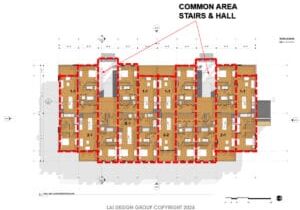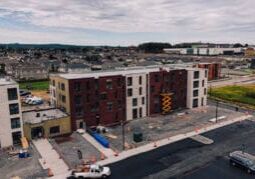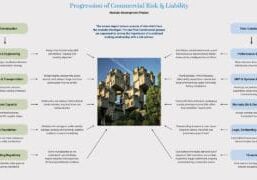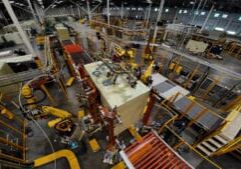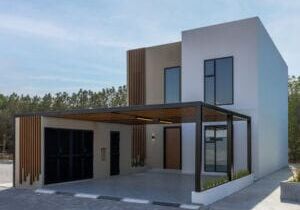Seeing the Potential for Modular Construction in Colombia

Andrés Felipe Becerra Ceballos is the Head of R&D at Constructora Bolívar
Founded in 1983, Constructora Bolivar specializes in the design, construction, project management, and sales of single family and multi-residential homes across the Colombian social strata.
From the company headquarters in Bogotá, Constructora Bolívar has become the largest developer and home builder in Colombia with over 60 active housing projects across the country. The company builds between 20-30,000 units each year. With plans to reach 40,000 units within the next two years, Andrés sees modular construction as a solution to scale production while lowering costs and shortening project timelines.
When asked about the state of the construction industry in Colombia, Andrés Felipe Becerra Ceballos, Constructora Bolivar’s Head of R&D, replied, “Like many other countries, Colombia is also experiencing a massive housing shortage right now. Currently, 1.2 million families have no place to call home. And with only 240,000 new housing units available each year, the housing shortage will be an ongoing issue in Colombia for years to come."
Commercial construction demand grew during the pandemic, despite material and labor shortages. And as Andrés explains, “The new homes and neighborhoods need schools, hospitals, and retail outlets. And although we have lower labor costs, commercial projects still rely on cast-in-place concrete or CMU (Concrete Masonry Units / cinder block masonry) to build interior and exterior walls, which are time-consuming compared to other options such as stud framing and drywall, or panelized exteriors. Part of the resistance to more conventional construction techniques is cultural. Concrete is readily available, fares well in our climate, and is viewed as the superior choice for seismic activity concerns.”
Unfortunately, modular construction is essentially non-existent in Colombia today. Only a handful of modular homes have been commissioned and built since 2015, mainly for extremely rugged and limited-access locations. Only one modular construction company has existed in Colombia. Founded in 2017, it employed 4 workers, and essentially shut down (revenue drop of 100%) in 2020 due to the pandemic1.
So why does the largest developer from a country with a struggling modular construction industry join the Modular Building Institute?

A Revit model from the first tower of Constructora Bolivar’s project "Salitre Living." This Bogota,
Colombia-based project will have 1,688 370-sq. ft. units.

A rendering of Constructora Bolivar’s upcoming “Alamo” project in Bogota, Colombia.
Exploring the Possibilities of Modular Construction
As part of his company’s due diligence, Andrés attended MBI’s 2022 World of Modular conference in San Antonio looking for information to help resolve his company’s scalability goal. Four days later he returned home with a crash course in modular construction under his belt and got to work.
As Andrés stated, “It was immediately obvious that modular construction could be the answer to several current construction issues we’re dealing with in Colombia today. By implementing modular construction techniques, we can provide a durable quality product, at a lower cost, in a shorter time frame, while minimizing waste, and promoting sustainability.”
Andrés also sees the societal benefits of modular construction for Colombia for addressing homelessness, improving natural disaster relief, more localized employment opportunities, and improving building codes, too.
The first step to “mainstreaming” modular construction in Colombia is the learning curve. While tried and tested around the globe, modular is essentially brand new to the entire country. Most homeowners haven’t seen it before, and they question everything from the products to the processes being used.
Constructora Bolivar plans to introduce modular construction to the Colombian property owners and developers of multi-family buildings. The belief is that, as they become aware of the lower construction and maintenance costs, and the higher return on investment (ROI), modular construction will establish a foothold. And as the developers continue to get on board, future homeowners and tenants are likely to follow.
When questioned about the timeline for getting past the learning curve, Andrés replied, “I can see it taking 3-5 years to get developers and architects on board. We’re already working with a wide variety of entities and programs to promote modular construction and its positive impacts on the local and national levels.”
Luckily, when these developers start looking for hard data and real-life examples, Constructora Bolivar has plenty of resources thanks to MBI and neighboring areas of Central and South America where modular construction is well established and flourishing.
Constructora Bolivar expects the modular learning curve for the public to take between 5-7 years. But the company isn’t sitting idly by and waiting for things to happen. Instead, it’s establishing connections with other modular builders, products, and vendors. The more other companies know, the easier the task of raising public awareness to the benefits of modular construction.
Getting Started
Establishing a modular construction industry will require a sizeable investment in R&D to get the needed infrastructure in place. Constructora Bolivar can’t wait to get started.
You can learn more about Constructura Bolívar people, products, and services at their website: https://www.constructorabolivar.com
More from Modular Advantage
AoRa Development Aims for New York’s First Triple Net Zero Building Using Modular Methods
More cities are providing funding for newer infrastructure projects as long as they meet sustainability requirements. This is how modular can fit the bill, thanks to its lower waste production.
Developers and Designers: Lessons Learned with Modular Design
Modular construction is attractive to many developers because sitework and module construction can occur simultaneously, shortening the schedule and reducing additional costs.
UTILE: Putting Modular Building on a Fast Track
In Quebec, UTILE is taking the lead in creating affordable modular buildings to help decrease the student housing shortage. During the process, the company discovered what it takes to make the transition to modular building a success.
Sobha Modular Teaches Developers How to Think Like Manufacturers
With its 2.7 million square foot factory in UAE, Sobha Modular is bringing both its high-end bathroom pods to high-end residences to Dubai while developing modular projects for the U.S. and Australia.
RoadMasters: Why Early Transport Planning is Make-or-Break in Modular Construction
In modular construction, transportation is often called the “missing link.” While it rarely stops a project outright, poor planning can trigger costly delays, rerouting, and budget overruns.
Navigating Risk in Commercial Real Estate and Modular Construction: Insights from a 44-Year Industry Veteran
Modular projects involve manufacturing, transportation, and on-site assembly. Developers must understand exactly what they are responsible for versus what they subcontract. Risk advisors should research the developer’s contractors, subcontractors, and design-build consultants—especially the modular manufacturer.
Art²Park – A Creative Application of Modular and Conventional Construction
Art²Park is more than a park building—it’s a demonstration of what modular construction can achieve when thoughtfully integrated with traditional materials. The use of shipping containers provided not only speed and sustainability benefits but also a powerful structural core that simplified and strengthened the rest of the building.
Building Smarter: A New Standard in Modular Construction Efficiency
Rising material prices, labour shortages, expensive financing and tightening environmental rules have made conventional construction slower, costlier, and more unpredictable. To keep projects on schedule and within budget, builders are increasingly turning to smarter industrialized methods.
Resia: Breaking All the Rules
Resia Manufacturing, a division of U.S.-based Resia, is now offering prefabricated bathroom and kitchen components to industry partners. Its hybrid fabrication facility produces more precise bathroom and kitchen components (modules) faster and at lower cost than traditional construction. Here’s how Resia Manufacturing does it.
How LINQ Modular Innovates to Bring Modular To The Market in the UAE and Beyond
LINQ Modular, with an office and three manufacturing facilities in Dubai, is a modular firm based in United Arab Emirates. The company is on a mission: to break open the housing and construction markets in the Gulf Cooperation Council (GCC) area with modular.


